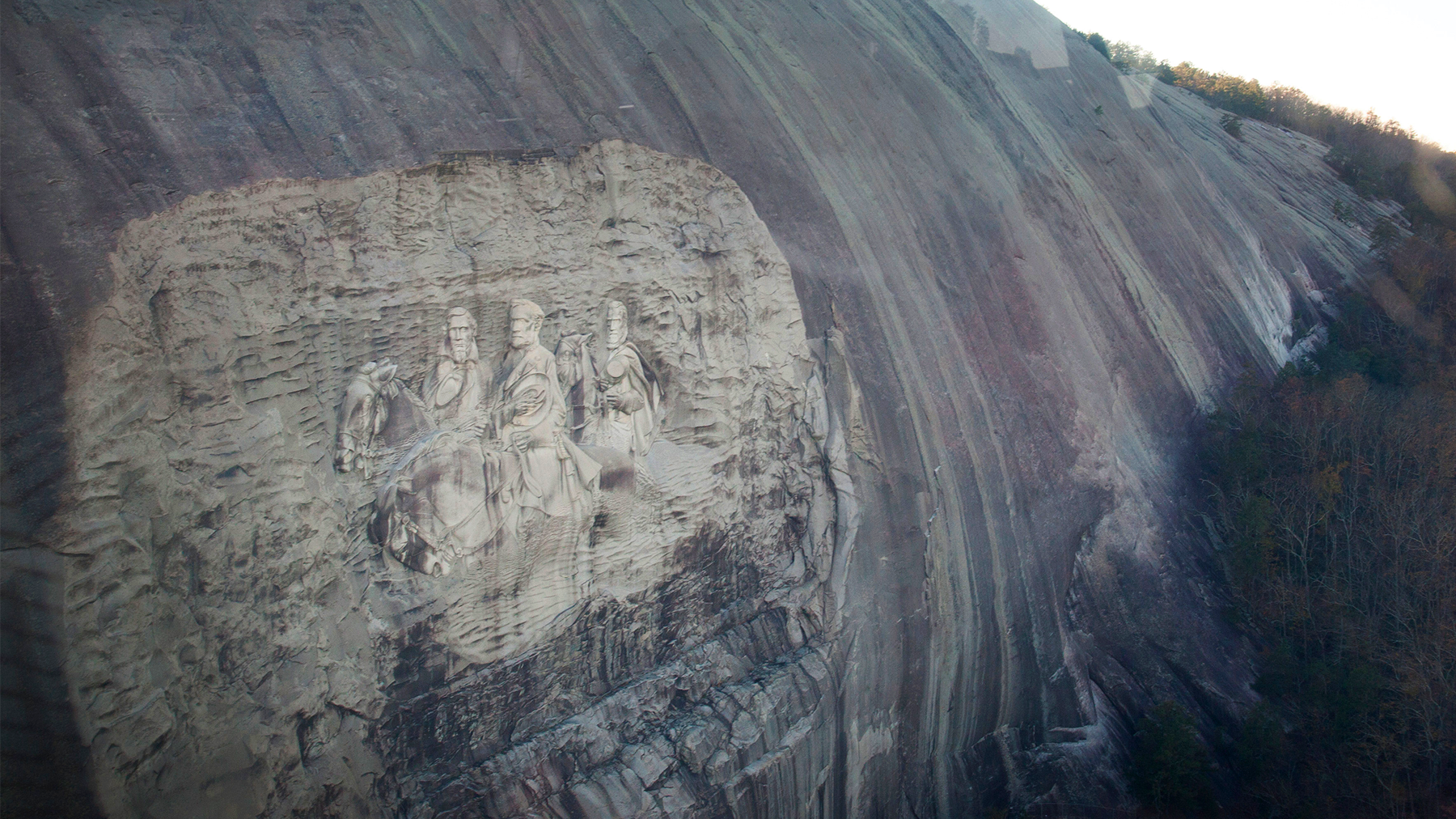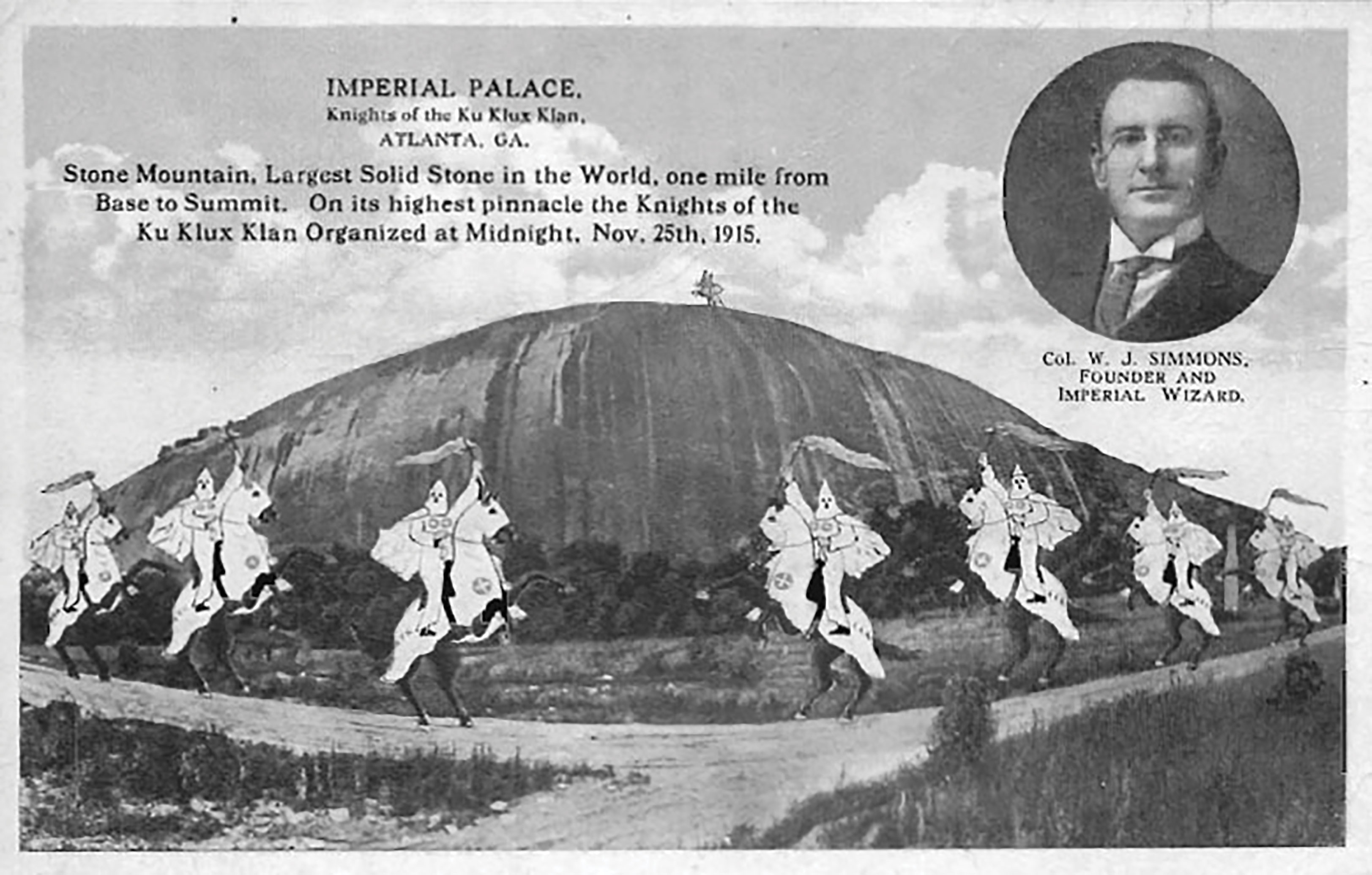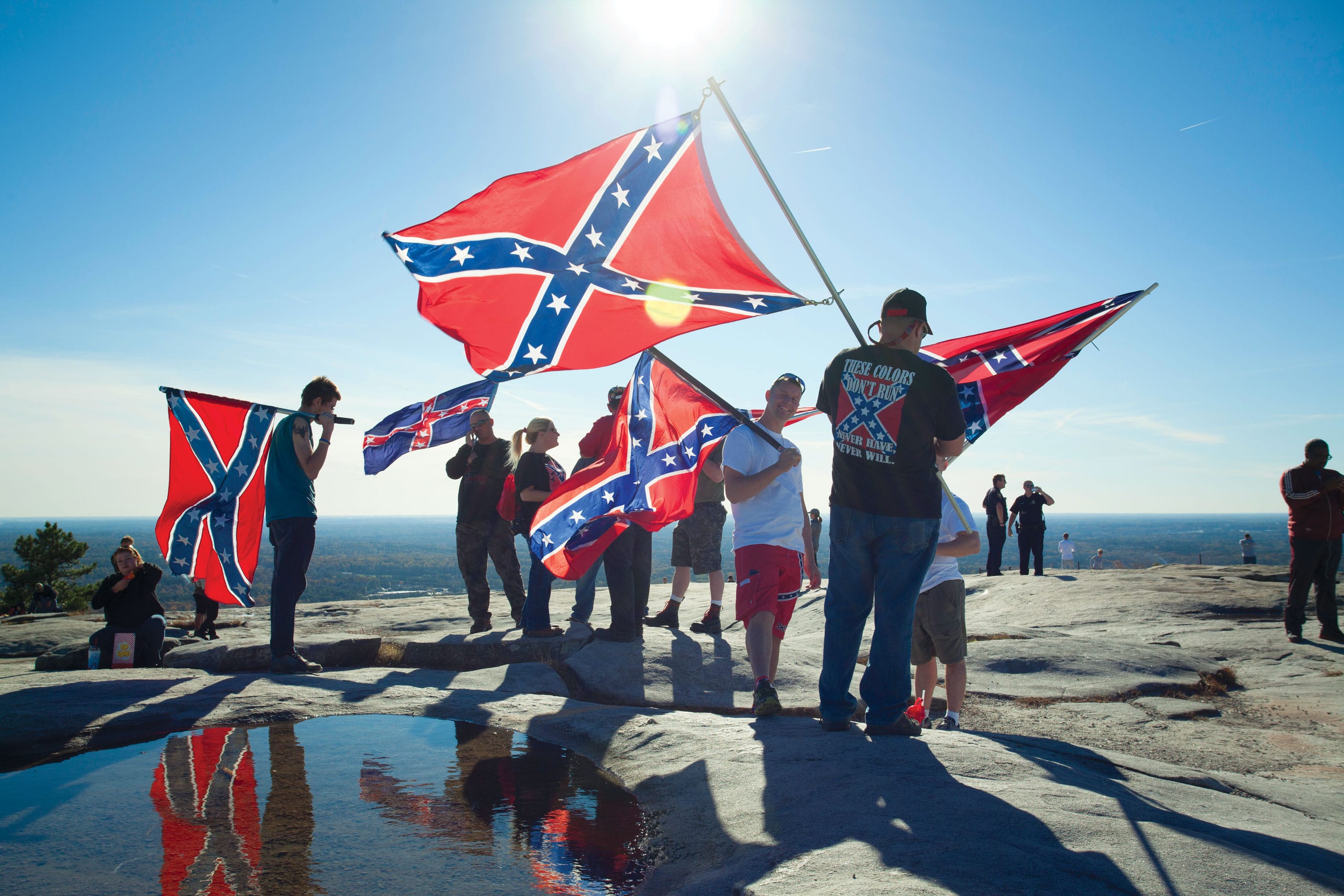Stone Mountain: A Monumental Dilemma
Some see the monument as “the largest shrine to white supremacy in the history of the world.”
From its north side, Stone Mountain is a formidable sight. Staggeringly steep, nearly five times as high as Niagara Falls, it rises from Georgia’s wooded landscape like a rogue wave.
This anomalous, igneous dome east of Atlanta is the centerpiece of a state park that draws 4 million visitors a year. Forty stories above ground, front and center on the gunmetal-gray face of the stone, is the largest bas-relief carving on the planet, a Civil War memorial to Jefferson Davis, Robert E. Lee and Thomas “Stonewall” Jackson. These leaders of the Southern rebellion against the United States sit astride their steeds, hats over their hearts, on a three-acre backdrop etched into the mountainside.
Stone Mountain is the Mount Rushmore of the Confederacy, only bigger. So big, a stonecutter could duck out of a downpour inside a horse’s mouth. Robert E. Lee is as tall as a nine-story building. Jefferson Davis’ nose is the size of a sofa.
Some see the carving as a memorial to rebel heroes and those who fought and died defending the Southern way of life. Activist Richard Rose sees it as “the largest shrine to white supremacy in the history of the world.”
“If you read the declaration of secession for those states, they make it clear in the first paragraph, even the second sentence, why they wanted to secede from the union.”
“The people of Georgia having dissolved their political connection with the Government of the United States of America, present to their confederates and the world the causes which have led to the separation. For the last ten years we have had numerous and serious causes of complaint against our non-slave-holding confederate States with reference to the subject of African slavery.”
Although the monument is protected by state law, Rose says it needs to go.
President of the Atlanta chapter of the National Association for the Advancement of Colored People (NAACP), Rose grew up in the civil rights movement, the “whites only” times. Such tributes to the Confederacy have haunted him all his life.
“I don’t think people understand the objective and the intent,” he said in a phone interview. “They don’t understand that it’s based on white supremacy because the war was based on white supremacy, and the ‘heroes’ are based on white supremacy.
“After the killings at Emanuel Church in Charleston, it finally crystallized for me that these monuments encourage violence and validate oppression.”
Two summers ago, 21-year-old Dylann Roof joined an evening Bible study at Emanuel African Methodist Episcopal Church in Charleston, South Carolina. Then, as worshippers closed their eyes to pray, he executed those around him, killing nine in all. Investigators later discovered his website filled with racist rantings and photos of him with Confederate flags and other symbols embraced by his kind.
After the massacre, Rose, speaking on behalf of Atlanta’s NAACP, and Charles Steele, president of the Southern Christian Leadership Conference (SCLC), called on Georgia Gov. Nathan Deal to remove “symbols of hate” from all state properties, including Stone Mountain.
As cities across the country wrestled with whether Confederate tributes should stay or go, Charlottesville cranked up the volume.
On August 12, a contingent of mostly angry white men, some donning battle gear and waving Confederate and swastika flags, gathered for a “Unite the Right” rally in Charlottesville, Virginia, to protest the removal of the Robert E. Lee statue from a city park. Clashes turned bloody, then murderous when a rally supporter plowed his vehicle into counter-protesters, injuring 19 and killing Heather Heyer, 32.
After Charlottesville, others joined the call for the Stone Mountain carving to come down, most notably African-American gubernatorial candidate Stacey Abrams, minority leader of the Georgia House of Representatives.
For Rose, it boils down to this:
“If Joe Blow wants to put a statue of Robert E Lee in his front yard or on his farm, I think that’s great. I mean, this is America; he ought to be able to do that. But the state of Georgia should not be doing that, the state of Alabama, the state of Virginia. Cities and counties should not be promoting white supremacy and racism.
“And there’s a law to protect it. The fact that the state says this makes it all the more onerous.”
The Klan’s sacred stone
The nearly 60-year effort it took to create this monument, from its first fundraising campaign in 1915 to finishing touches in 1972, makes quite the compelling story. Historical photos show stonecutters dangling from cables and perched on swings halfway down the mountain’s 825-foot face. One crewman died in 1927 when a chunk of rock loosened by dynamite let go, hit his platform and catapulted him into the air. Another was killed in 1966 when a scaffold plank slipped out of place.
Carving these figures into the mountainside took courage, strength and skill. But there’s an odious side to the story.
In 1915, the second coming of the Ku Klux Klan occurred atop Stone Mountain. Klan money helped fund the monument. And the first of its three head sculptors was a Klansman, as was the owner of the mountain, Samuel Venable, whose family bought it in 1887 to run a quarry. Venable granted the Klan rights to hold meetings there in perpetuity. And for decades it did.
Two events sparked the revival of the Klan, which swept the South during Reconstruction before fizzling in the 1870s.
Fueled by anti-Semitism, the first was the lynching of Leo Frank, a Cornell graduate and Jewish superintendent of an Atlanta factory, who was convicted in a shoddy trial of the murder of a 13-year-old Christian girl. After Frank’s death sentence was commuted to life, an armed mob snatched him from prison while guards did nothing to stop it. The men drove Frank to the girl’s hometown and hung him from an oak tree. (Decades later a witness came forward and, in 1986, the Georgia Board of Parole granted Frank a posthumous pardon.)
The other provocation was the Atlanta debut of D.W. Griffith’s Birth of a Nation, a silent film portraying African Americans as savages and sex fiends who defiled white women, while glorifying the KKK as saviors galloping to the rescue.
On Thanksgiving night, William J. Simmons led a group of 15, including some members of the Frank lynching mob, to the summit of Stone Mountain, where they set up a flag-draped altar, opened a Bible and burned a 16-foot cross in an initiation ceremony described in Atlanta’s Stone Mountain: A Multicultural History, by Paul Stephen Hudson and Lora Pond Mirza.
The resurrected KKK targeted primarily blacks, but also Jews, Catholics and foreigners among others.
Although the idea of carving a monument into Stone Mountain had floated about for years, Civil War widow Helen Plane made it her mission. As a charter member of the United Daughters of the Confederacy, champions of the “Lost Cause” version of the Civil War, she had both the passion and the sway. Once Gutzon Borglum was chosen as the sculptor in 1915, she wrote him with a design suggestion.
“I feel it is due to the Klan which saved us from Negro dominations and carpetbag rule, that it be immortalized on Stone Mountain. Why not represent a small group of them in their nightly uniform approaching in the distance?”
Due to funding challenges and World War I, the jackhammers, drills and explosives didn’t descend upon the mountain until 1923. Borglum had grandiose visions of carving an army of Confederates in addition to the three leaders, as many as 1,000 figures sweeping across the mountain. But after a year’s work, all he’d completed was Lee’s head.
Project managers fired him and later pressed charges when he destroyed his models. Borglum fled the state and went on to carve Mount Rushmore in the Black Hills of South Dakota on sacred Lakota land.
Augustus Lukeman took over, but slammed into the deadline before finishing. In 1916, Venable had granted a 12-year lease to complete the carving, and time was up. The project sat mothballed for the next 36 years.
The Supreme Court’s Brown v. Board of Education integration decision and rise of the Civil Rights Movement jump-started interest in completing the carving. In 1958, under Georgia’s segregationist governor, Marvin Griffin, the state created the Stone Mountain Memorial Association and purchased the dome and surrounding land to create a memorial park.
Carving resumed July 1964 with its third head sculptor, Walter Kirtland Hancock. Eight years later it was finished.
The state’s purchase of Stone Mountain voided Venable’s agreement with the Klan, but that hasn’t stopped sympathizers and other white supremacists from making pilgrimages to their sacred ground of hate. And, it’s hard to ignore the timing of the park’s official grand opening on April 14, 1965 — 100 years to the day that President Abraham Lincoln was shot.
Looking the other way
Stone Mountain Park has a lot more going on than its Confederate monument. The 3,200-acre tourist mecca offers an amusement park, hiking, boating, golfing, a laser show, a plantation, slave quarters included, and more. A tram takes visitors to the top, where chain-link fencing keeps them from sliding into oblivion. In addition to views, there’s a 312-foot transmission tower, restrooms and a snack bar smelling of popcorn.
On a recent fall morning, on a scenic drive around the mountain via Robert E. Lee Boulevard and Stonewall Jackson Drive, tangerine and marigold leaves skittered across the pavement on a light breeze as the road traversed bridge after bridge over the meandering, manmade Stone Mountain Lake. People were everywhere, running, strolling, biking, dog walking, the vast majority black, white, and black and white together.
The park draws all races and ethnicities. One moment you see a ball cap with Confederate battle-flag symbols, the next a hijab and veil.
“If you don’t look at the monument, and for me you can’t look at the street names either, but, you know, it’s a state park,” Richard Rose said. “You can go camping, there’s a golf course, you can rent a boat and go on the lake. They have a couple hotels, a campground. But it’s a monument to the Confederate States of America.
“Every monument is a celebration of something, a person’s life or some significant event. This represents a celebration of the attempt to maintain slavery as an institution in America.”
Yet, it’s highly doubtful the carving controversy is at the forefront of most park visitors’ minds. Standing at a viewing area across from the monument, a black couple from the Atlanta area looked puzzled when asked their thoughts on the topic.
“I don’t even know who that is up there,” the woman shrugged.
Another man, white and fully aware of the controversy, took a long, hard look at the monument, but unlike most had no interest in having his picture taken before it. Instead, he said he felt like taking a knee.
More than a stone
George Coletti grew up in Stone Mountain Village just outside the park boundary and is the author of two Civil War-era novels, including Stone Mountain: The Granite Sentinel, a story steeped in local history, as is his family, which first settled there as immigrants from the Middle East in the early 1920s.
“My granddaddy’s store was right where Confederate Hall is now,” he said of one of the park’s attractions. “He owned a pre-Civil War hotel where the parking lot is. When they went back to Lebanon to visit family, a telegraph came that said the Klan had burned down his hotel. He wouldn’t put a ‘whites only’ sign up.”
Coletti’s uncle, Elias Nour, became known as the Old Man of the Mountain way before he was old. As told in Carved in Stone: The History of Stone Mountain by David B. Freeman, between 1927 and 1963, Nour rescued 36 people, and six dogs, who slipped or wandered too far over the mountaintop’s deceptive, rounded edge, his first at 13. Nour’s eccentric resume included driving a Model T Ford covered in anti-Depression slogans to the top of the mountain, lighting oil-soaked rags on fire and sending the flaming vehicle flying over the edge to crash onto rocks below. Years later he repeated the stunt with a vehicle carrying Hitler, Mussolini and Tojo effigies.
Even if Coletti’s family history weren’t so deeply intertwined with that of Stone Mountain’s, he’d adamantly oppose removing the carving.
“It’s history,” he said emphatically. “You can’t destroy history. It’s more culture than it is racist I think.
“Some people don’t have anything better to do than start controversy. In my opinion, a few people want to stir up trouble and cause friction between the races.”
Rama Roy, daughter of an immigrant father from India and a white mother, has her own deep connection to Stone Mountain. She lives closer to Atlanta now but once lived walking distance to the park entrance and has climbed the mile-long, west-side trail to the top more times than she can count. For sunrises and sunsets. For reflections on her life.
“There’s a lot of Native American energy there,” she said. “Preceding all this recent history, whenever I go there I feel more of the ancient vibe. It’s more than just a rock that you go and exercise on. It can really give back a lot, too.”
But then there’s that carving on the north face. It’s not visible from the hiking trail, but just knowing it’s there and is painful to others makes it not OK with her.
“People from all over the world come to Stone Mountain … and I don’t want them leaving with the perception that we just don’t care or that we are backward or still thinking in those ways. Because most of us aren’t.
“There are people who are still being oppressed by these symbols, and that’s why they need to be gone.”
Semper Idem
Less than two months after the Emanuel Church massacre, as the debate over Confederate flags and monuments was ramping up, roughly 700 people from the Sons of Confederate Veterans, the League of the South and others rallied at Stone Mountain, “convinced their way of life and legacy were under attack,” as The Atlanta Journal-Constitution reported.
A proposed bell tower to honor Martin Luther King’s I Have a Dream speech — “Let freedom ring from Stone Mountain of Georgia!” — also drew protestors, some flaunting assault rifles, for a “Defend Stone Mountain” rally in support of “keeping the mountain ‘pure’ to its Confederate roots,” the paper reported.
The NAACP, SCLC and others didn’t like the idea, either, of honoring a man like King at a place like that.
In granting rally permits, the Stone Mountain Memorial Association has to decide between honoring “free speech events” and concern for public safety at its family-oriented park. Last spring, it closed attractions after a white power rally coinciding with Confederate Memorial Day and Adolf Hitler’s birthday became turbulent, and nine counter-protesters were arrested. Last summer, the association rejected a Klan request for a cross-burning ceremony to commemorate the 1915 resurrection.
Stone Mountain, despite its attributes, can’t seem to shake the shadows of its past. As it says in Latin on lynching victim Leo Frank’s tombstone: “Semper Idem.”
“Always the same.”
To stay or go
Removing a statue is one thing; removing a gargantuan carving embedded 42 feet into the heart of a mountain is something else entirely. But it’s not unprecedented. In the spring of 1928, after Lukeman took over, Borglum’s sculpture of Robert E. Lee was blasted to bits.
Some have suggested filling it in and putting some other artwork over it. Or, maybe it could be carefully dismantled and relocated somewhere other than state property.
Andrew Young, former Atlanta mayor, Congressman and United Nations ambassador who was with Martin Luther King when he was assassinated, doesn’t want any of that to happen.
“That is a tremendous carving, and I don’t want to see that destroyed,” he told National Public Radio.
He’s worried it would make racial tensions worse. As for the activists who disagree:
“These are kids who grew up free, and they don’t realize what still enslaves them — and it’s not those monuments,” he said.
Atlanta Journal-Constitution guest columnist R.K. Sehgal put it this way:
“I compare erasing the Stone Mountain carving to the way a middle-aged adult might view removing an unfortunate teen-aged arm tattoo. He can cut off his arm, an extreme remedy. He can attempt medical removal, resulting in a disfigured reminder of his bad decision. Or he can leave it as-is, a clear reminder of bad choices on his journey and use it as a lesson about how to create a better future. Art is always instructive if we let it speak to us. Even when it tells a sad story, eventually it coaxes insights and learning of history, liberation, reconciliation, and a positive way forward.”
Richard Rose has received death threats by calling for the carving’s removal.
“I understood what I was going to be facing to start with, but it’s a matter of principle. America cannot find peace until it solves its racial problem institutionally.
“I know it’s a long-term project. But I have granddaughters, and I want my granddaughters and great-grandchildren to grow up in an America that’s free from government-sponsored terrorism.”





